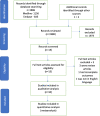Locked compression plating versus retrograde intramedullary nailing in the treatment of periprosthetic supracondylar knee fractures: a systematic review and meta-analysis
- PMID: 33482862
- PMCID: PMC7821478
- DOI: 10.1186/s13018-021-02222-x
Locked compression plating versus retrograde intramedullary nailing in the treatment of periprosthetic supracondylar knee fractures: a systematic review and meta-analysis
Abstract
Background: Periprosthetic fractures of the distal femur above a total knee arthroplasty (TKA) have traditionally been managed by locking compression plating (LCP). This technique is technically demanding and is associated with high rates of non-union and revision. More recently, retrograde intramedullary nailing (RIMN) has been proposed as an acceptable alternative. This meta-analysis aims to evaluate clinical outcomes in patients with periprosthetic supracondylar femoral fractures who were treated with LCP and RIMN.
Methods: An up-to-date literature search was carried out using the pre-defined search strategy. All studies that met the inclusion criteria were assessed for methodological quality with the Cochrane's collaboration tool. Operative time, functional score, time-to-union, non-union rates and revision rates were all considered.
Conclusion: Ten studies with a total of 531 periprosthetic fractures were included. This meta-analysis has suggested that there is no significant difference in any of the outcome measures assessed. Further, more extensive literature is required on the subject to draw more robust conclusions.
Keywords: Fixation; Fracture; Periprosthetic; TKR; Trauma.
Conflict of interest statement
The authors whose names are listed immediately below certify that they have no affiliations with or involvement in any organisation or entity with any financial interest (such as honoraria; educational grants; participation in speakers’ bureaus; membership, employment, consultancies, stock ownership, or other equity interest; and expert testimony or patent-licensing arrangements), or non-financial interest (such as personal or professional relationships, affiliations, knowledge or beliefs) in the subject matter or materials discussed in this manuscript.
Figures






Similar articles
-
Similar outcomes of locking compression plating and retrograde intramedullary nailing for periprosthetic supracondylar femoral fractures following total knee arthroplasty: a meta-analysis.Knee Surg Sports Traumatol Arthrosc. 2017 Sep;25(9):2921-2928. doi: 10.1007/s00167-016-4050-0. Epub 2016 Feb 20. Knee Surg Sports Traumatol Arthrosc. 2017. PMID: 26897137 Review.
-
[Osteosynthesis for periprosthetic supracondylar fracture above a total knee arthroplasty using a locking compression plate].Acta Chir Orthop Traumatol Cech. 2009 Dec;76(6):473-8. Acta Chir Orthop Traumatol Cech. 2009. PMID: 20067694 Czech.
-
Locked plating of periprosthetic femur fractures above total knee arthroplasty.J Orthop Trauma. 2012 Jul;26(7):427-32. doi: 10.1097/BOT.0b013e31822c050b. J Orthop Trauma. 2012. PMID: 22357080
-
Treatment of supracondylar periprosthetic femoral fractures with retrograde intramedullary nailing versus distal femoral plating: A systematic review and meta-analysis of current evidence.Orthop Traumatol Surg Res. 2023 Sep;109(5):103489. doi: 10.1016/j.otsr.2022.103489. Epub 2022 Nov 25. Orthop Traumatol Surg Res. 2023. PMID: 36442809
-
Comparison of retrograde nailing and minimally invasive plating for treatment of periprosthetic supracondylar femur fractures (OTA 33-A) above total knee arthroplasty.Arch Orthop Trauma Surg. 2016 Mar;136(3):331-8. doi: 10.1007/s00402-015-2374-8. Epub 2015 Dec 8. Arch Orthop Trauma Surg. 2016. PMID: 26646847
Cited by
-
Optimal surgical treatment for periprosthetic distal femoral fractures after total knee arthroplasty: a Bayesian-based network analysis.J Orthop Surg Res. 2023 Feb 20;18(1):122. doi: 10.1186/s13018-023-03586-y. J Orthop Surg Res. 2023. PMID: 36803522 Free PMC article.
-
Dual Construct for Very Low Periprosthetic Distal Femur Fracture-Case Series and Extensile Medial Parapatellar Single Incision Approach.Geriatr Orthop Surg Rehabil. 2025 Jun 19;16:21514593251352332. doi: 10.1177/21514593251352332. eCollection 2025. Geriatr Orthop Surg Rehabil. 2025. PMID: 40546848 Free PMC article.
-
Periprosthetic Distal Femoral Fractures Around a Total Knee Arthroplasty: a Meta-analysis Comparing Locking compression Plating and Retrograde Intramedullary Nailing.Orthop Rev (Pavia). 2024 Jan 6;16:91507. doi: 10.52965/001c.91507. eCollection 2024. Orthop Rev (Pavia). 2024. PMID: 38765295 Free PMC article.
-
Distal femoral replacement for the treatment of periprosthetic distal femoral fractures around a total knee arthroplasty: a meta-analysis.Orthop Rev (Pavia). 2024 Apr 23;16:94574. doi: 10.52965/001c.94574. eCollection 2024. Orthop Rev (Pavia). 2024. PMID: 38666188 Free PMC article.
-
Nail diameter significantly impacts stability in combined plate-nail constructs used for fixation of supracondylar distal femur fractures.OTA Int. 2022 Feb 15;5(1):e174. doi: 10.1097/OI9.0000000000000174. eCollection 2022 Mar. OTA Int. 2022. PMID: 35187412 Free PMC article.
References
-
- Crowninshield RD, Rosenberg AG, Sporer SM. Changing demographics of patients with total joint replacement. Clin Orthop Relat Res. 2006:266–72. 10.1097/01.blo.0000188066.01833.4f. - PubMed
Publication types
MeSH terms
LinkOut - more resources
Full Text Sources
Other Literature Sources
Medical
Miscellaneous

